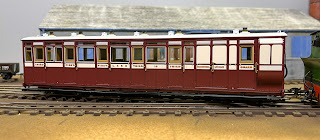Lionheart L&B Carriages
Back at the beginning of the month, I wrote (some might say gushingly) about the Lionheart L&B Manning Wardle rtr O-16.5 models that had arrived and mentioned that the carriages were due imminently.
The carriage that I’d ordered duly arrived but other distractions mean that I’m only just writing about it now. The first distraction was that at the time of his passing, my mate Neil was the Editor of ‘Narrow News’ the newsletter for the 7mm Narrow Gauge Association and sent out bi-monthly with the ‘Narrow Lines’ magazine. Following his passing, I volunteered to take over as Editor. My first issue is at the printers currently and will be landing on people’s doormats in the next week or so.
Secondly, I have two union rep hats at work, Local Level and H&S Rep. The first has required the new links for the December timetable change to be produced. Whilst I’ve used the skills gained from the latter to carry out a working at height review for working on the Talyllyn locos. Prompted by the accident and prosecution of another Heritage Railway by the ORR last year to make sure that we are on top of our game.
Thirdly, it was my daughter’s birthday yesterday and there have been celebrations, parties and family gatherings taking priority.
Now though, there is a brief window before Christmas whereby modelling can receive more of my attention.
But before that, a brief mention of my latest purchase… one of the Lionheart L&B carriages in the Edwardian livery to go with my loco. In short, these are just as stunning as the locos. Quickly unpacked, the carriage ran just as smoothly on ‘Wheal Ponder’ as the loco does.
Three styles of carriage have been produced, brake carriages 15 & 16, enclosed third carriages 11-14 and semi open carriages 7-10 in early and later independent liveries and Southern Railway livery. Brake third carriage 15 was converted at an early date to a brake composite and is reflected in the liveries chosen for this vehicle. The carriage liveries are very crisply reproduced. The carriage roofs clipped on, removal is relatively straight forward and explained in the instructions, making the addition of passengers or a DCC chip easy. Interior lighting is fitted which varies according to the power applied on DC and is controllable to be off or on when a DCC chip is inserted.
I am very impressed with these models, to my eye some of, if not the best rtr models I have ever seen. The level of detail is superb and the removable carriage roofs are a clever touch. Topped off with exceedingly crisp and well applied liveries.
The models are fitted with working chopper couplings, with steel choppers which can be operated by magnet on stick style devices as favoured by some 7mm standard gauge modellers using three-link couplings. This has potential for the number of 7mm narrow gauge modellers seeing beyond tension lock and kadee couplers for a finer alternative to increase. The couplings on the rear of the loco and the carriages are pivoted with slots provided in the buffer beams and headstocks. To my eye this is a sensible compromise between fidelity and commercialism that does not detract too much from the model.
Whilst the O14 modeller will be disappointed that true to scale 14mm gauge hasn’t been provided by Lionheart. Presumably, the very small numbers not making it commercially viable, Paul at EDM Models is working on the 14mm gauge conversions. Personally, I’m not so fussed and will be running these on 16.5mm gauge track. These are some of the finest rtr locos and carriages I have seen and the finish is better than I could manage myself.
These fine models have left me with something of a dilemma. I hold a fondness for the old L&B and these very fine models make me feel compelled to do something with them. The fine quality brings on thoughts of trying hand built track again and using the proper chopper couplings so in fact could help improve my own standards. But, they don’t fit into my current modelling plans and whilst I’ve had the L&B books out, all the stations are of the large and sprawling nature and don’t lend themselves to a compact branch line terminus layout. I’m intrigued to see what people use these locos and carriages on, I suspect on layouts that are really too small for them. But, modellers are fond of their quaint branch line termini and the L&B was the one narrow gauge railway that was the closest to the quintessential branch line general carrier as you could have got.



Comments
Post a Comment